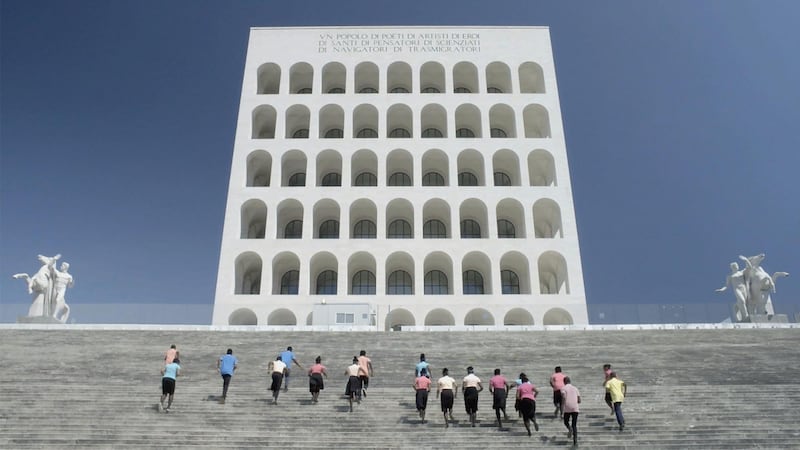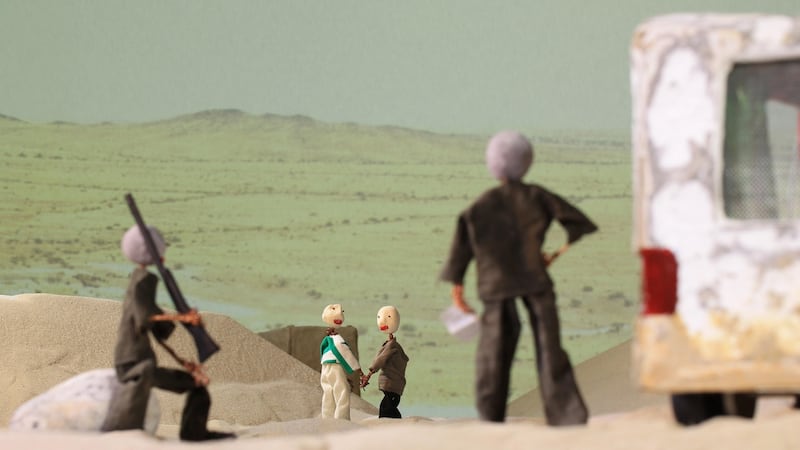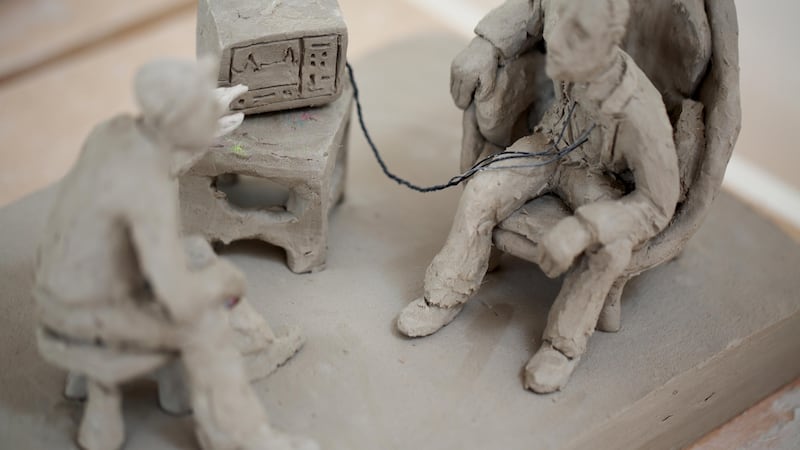Freedom of Movement – Nina Fischer & Maroan el Sani
★★★
The Mart Gallery
What do we think of when we hear the word "race"? In Nina Fischer & Maroan el Sani's three-channel video, Freedom of Movement (2017), a black man runs barefoot. On a second screen, archive footage unfolds the story of Abebe Bikila's extraordinary gold medal-winning marathon through Italy's EUR district at the 1960 Olympics. On the third, a choir of black children sing at some of the EUR's gleamingly white edifices. A voiceover muses on themes, from imperial obsessions with preservation and greatness, to how architecture can be designed to control a population.
The narrator also tells of the Ethiopian Bikila's record-breaking barefoot race, and how his cue to put on a final sprint came at the site of the huge obelisk, looted from his home country by invading Italian forces in the second Italo-Ethiopian War. The war took place between 1935 and 1936, bringing with it unprecedented levels of approval to the Fascist dictator Benito Mussolini. For a certain kind of leader, war is very popular.
Scenes of Bikila’s race are cut with footage of the building of the EUR, a residential and business district, created as an adjunct to Rome, but also designed to embody and celebrate the principles of Fascism, cementing their connection to the ancient Roman Empire. We see Mussolini himself laying mosaics on an EUR pavement, the images symbolic of Roman and Fascist values. Cut then to see Bikila flowing, perfectly judged step by step, over these same mosaics as he holds victory in his hands. The race was run just 25 years after Italy’s invasion of his own country.

The narrative switches, subtly, to those other meanings of the word “race”. The race for survival as people flee war in their own countries, and race as a barrier to living to your full potential – or to living at all. The brilliance of this video installation, at just nine minutes and 45 seconds, is that there’s nothing heavy-handed. Nothing overstated.
Quest for power
Watching, I’m filled with joy at Bikila’s perfect achievement, and despair at what humans can visit upon one another in the quest for power. The refugees making their ways to Europe are victims of centuries-long programmes of exploitation and oppression by the very countries that now baulk at their own cultures being at risk of alteration by new arrivals. Ethiopia, by the way, is said to be the place from which modern humans first set out towards the Middle East, and beyond.
Fischer and el Sani are a pair of German artists, whose work is exemplary for nudging you to think about such things. Their second piece at The MART is Identity's Rule of Three (2016), an animated film that attempts to get to grips with the foundations of identity, whether in the individual, a group or society at large. It is divided into three phases, and I admit I got a little lost in the middle section where the narrative moved from a clever claymation sequence showing how if you get people to act out the role of an extrovert or introvert, they're more likely to claim those characteristics later, on to a mini-drama in the life of an artist.

Never mind – because the final act, focusing on a quartet of characters fleeing Despotsville for Elitesville, is just brilliant. Musing on the construction of character by riffing on the life of Justin Bieber, they consider the role of insiders and outsiders, as well as how the framework for who takes which position in a society are formed by the values of that society, rather than any immutable personal qualities. This keeps society going, but it's not so great for those authentic individuals who don't fit in.
In a district of Elitesville, there’s a castle. Once it was a palace. Successive regimes ripped it down and built it up again, each wanting to reflect their own greatness. Then the money ran out, and now it’s a shelter for the dispossessed who have created their own rules for a functioning society. How did it come to this, the narrator asks at the end of the video? How did such powerful rulers fall?
Watch this film, and the unsettling answers will come to you. The next question is: can we go back out into the world and help to try to prevent our own fall, to get it right this time?
[ mart.ieOpens in new window ]

The Museum of Modern Comedy in Art (MoMCo) – A Proposal
★★
Project Arts Centre, Dublin
An exhibition with a title this long evidently has a serious bent, even if its subject matter is comedy in art. This is underlined by the presence of a large wall chart at one end of the gallery, subtitled "a tentative chart of topics, vectors and areas of research". Muse on it and there are some intriguing gems. I hadn't known that pop artist Roy Lichtenstein came to paint images of Disney characters because he'd needed something for show-and-tell at his son's school (maybe I should, or perhaps it's a myth); though I had heard rumours that the underpainting on Kazimir Malevich's famous 1915 painting Black Square shows a handwritten caption that reads: "Negroes battling in a cave". Is that funny? It certainly doesn't fly in today's culture.
"The majority of current contemporary art is comical, either knowingly or unwittingly," reads another note by exhibition co-curator and main artist Olav Westphalen. Westphalen's little clay creations showing moments from art history are on plinths throughout the exhibition. There's our own Brian O'Doherty taking Marcel Duchamp's electrocardiogram in 1966. There's also Malevich painting his Black Square, Lichtenstein at his son's school, and Mierle Laderman Ukeles. She came up with the idea of "maintenance art" in the 1960s as a way to draw attention to undervalued roles in society.
Plunged into gloom
Periodically, the gallery is plunged into gloom as a series of five videos play. This was initially frustrating as I was trying to read the chart, before I realised it’s reproduced on the exhibition handout, albeit in tiny print, so I didn’t have to take it all in immediately. There are some moments of interest in the videos: Westphalen’s own shows an animated plank of wood wandering through endless tunnels, ignoring opportunities to exit, sticking to the familiar paths.

The problem is that – as anyone who ever made the mistake of attempting to explain a joke will know – unpacking comedy just isn’t funny. Sure, the exhibition makes a good point that some of the pivotal points in contemporary art history weren’t undertaken with the deep gravitas with which we may now study them. It also touches on the idea that comedy itself is disruptive, frequently pulling at loose threads in certainties – just like art; but, oddly enough for an exhibition on this subject, and despite the playful clay sculptures, the overriding sense is that it all takes itself way too seriously.
Project Arts Centre, 39 East Essex Street, Temple Bar, Dublin 2. Until October 21st projectartscentre.ie












